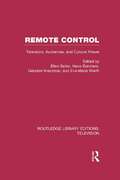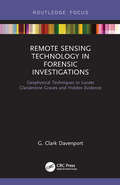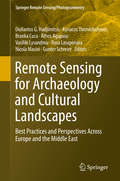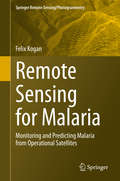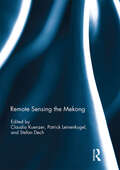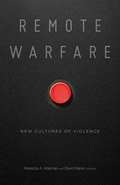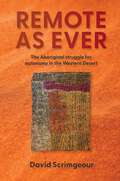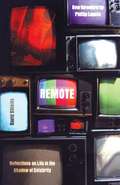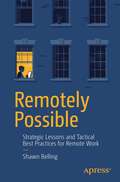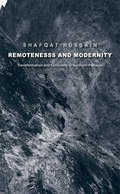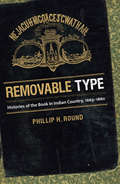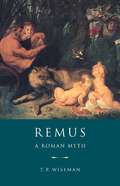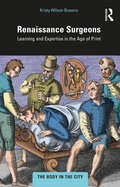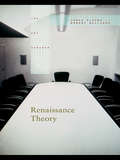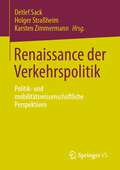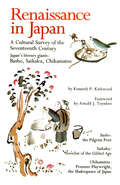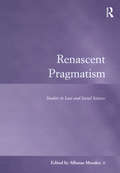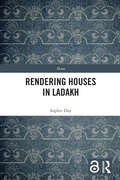- Table View
- List View
Remote Control: Television, Audiences, and Cultural Power (Routledge Library Editions: Television)
by Ellen Seiter Hans Borchers Gabriele Kreutzner Eva-Maria WarthThe ways in which we watch television tell us much about our views of gender, the family and society. Bringing together the leading experts in the field of audience studies, this book investigates how viewers watch television, and what they think about the programmes they see. Originally published in 1989, the book is divided into two sections which discuss some of the theoretical issues at stake and then present case studies of a wide range of viewers: women office workers, Israeli watchers of Dallas, German families, the elderly, and American daytime soap fans. Contributors from Britain, the United States, Western Europe, Australia and Israel offer a wide range of perspectives, from feminism to post-modernism, and from semiotics to Marxism. ‘Together these essays constitute one of the best possible introductions to the leading edge of research into the phenomenon of television.’ Choice
Remote Freedoms: Politics, Personhood and Human Rights in Aboriginal Central Australia (Stanford Studies in Human Rights)
by Sarah E. HolcombeWhat does it mean to be a "rights-holder" and how does it come about? Remote Freedoms explores the contradictions and tensions of localized human rights work in very remote Indigenous communities. Based on field research with Anangu of Central Australia, this book investigates how universal human rights are understood, practiced, negotiated, and challenged in concert and in conflict with Indigenous rights. Moving between communities, government, regional NGOs, and international UN forums, Sarah E. Holcombe addresses how the notion of rights plays out within the distinctive and ambivalent sociopolitical context of Australia, and focusing specifically on Indigenous women and their experiences of violence. Can the secular modern rights-bearer accommodate the ideals of the relational, spiritual Anangu person? Engaging in a translation of the Universal Declaration of Human Rights into the local Pintupi-Luritja vernacular and observing various Indigenous interactions with law enforcement and domestic violence outreach programs, Holcombe offers new insights into our understanding of how the global rights discourse is circulated and understood within Indigenous cultures. She reveals how, in the postcolonial Australian context, human rights are double-edged: they enforce assimilation to a neoliberal social order at the same time that they empower and enfranchise the Indigenous citizen as a political actor. Remote Freedoms writes Australia's Indigenous peoples into the international debate on localizing rights in multicultural terms.
Remote Sensing Technology in Forensic Investigations: Geophysical Techniques to Locate Clandestine Graves and Hidden Evidence
by G. Clark DavenportRemote Sensing Technology in Forensic Investigations provides a basic understanding of concepts involved in the use of basic geophysical surveying, metal detectors, magnetics, electromagnetics and ground penetrating radar in police and forensic investigations. Such technology can be vital in locating clandestine, buried evidence which is often concealed in the subsurface underground. Crime scene investigation and evidence collection entails locating, identifying, collecting, and cataloging. Such physical evidence searches are time consuming and can often lead to searches that require excavations, which in itself that can destroy evidence. The noninvasive, nondestructive methods outlined in this book can both reduce the time spent on searches and excavations, thereby increasing the probability of locating vital physical evidence. As such, the application of remote sensing methods has gained increased acceptance, and seen increased usage, by investigators. Remote sensing methods are based on making indirect measurements of the surface of and within the earth. The resulting measurement information can be presented in either an imaging format— such as in aerial photography—or a non-imaging format, such as in a profile or contour map. These measurements can be interpreted to identify and characterize contrasts due to differences in physical and natural properties of the materials being studied. This can include physical evidence, remains, and clandestine graves. This book will serve as a handy introductory primer to the technology, techniques, and application of such techniques. Throughout, numerous references and additional resources are provided for those investigators, forensic anthropology, and police professionals who want further information on the technology’s usage for investigative purposes.
Remote Sensing and Geographic Information Systems for Policy Decision Support (Advances in Geographical and Environmental Sciences)
by R. B. Singh Manish Kumar Dinesh Kumar TripathiThe management of data to understand complex and interwoven processes of sustainable development has been a great challenge for researchers, planners, and decision makers. Remote sensing and GIS-based policy decision support systems not only help them to solve spatially related environmental and socio-economic issues; they also provide a powerful tool for integrating spatial and non-spatial datasets with analytical and spatial models and knowledge domains. Recent advances in the modern spatial tools of remote sensing and GIS combined with advanced computation techniques have enhanced the efficiency and capabilities of policy development. This book expands the scientific knowledge base in various physical and socio-economic issues among scholars, planners, and decision makers for policy development and research regarding sustainable development. It also demonstrates the importance of modern spatial decision support tools of remote sensing and GIS to better understand sustainable development processes and policy development. Furthermore, the book discusses case studies providing new insights as to how remote sensing and GIS-based decision support systems contribute to understanding physical and socio-economic processes and developing pragmatic policy for sustainable development.This book covers land surface temperature, hydrological processes, terrain mapping, flood and landslide hazards, land use and land cover dynamics, crime hotspots, urban health issues, tourism, agriculture, forest management, flood mitigation, urban sprawl, and village information systems, among others. Readers will find this book to be an invaluable resource for understanding and solving diverse physical and human issues for policy development related to sustainable planning and management.
Remote Sensing for Archaeology and Cultural Landscapes: Best Practices and Perspectives Across Europe and the Middle East (Springer Remote Sensing/Photogrammetry)
by Nicola Masini Rosa Lasaponara Diofantos G. Hadjimitsis Kyriacos Themistocleous Branka Cuca Athos Agapiou Vasiliki Lysandrou Gunter SchreierThis book investigates the added value that satellite technologies and remote sensing could provide for a more sustainable mapping, monitoring and management of heritage sites, be it for purposes of regular maintenance or for risk mitigation in case of natural or man-caused hazards. One of the major goals of this book is to provide a clear overview on policy perspectives, regarding both space policy as well as heritage policy, and to provide possible suggestions for common ground of these two fields, in Europe and around the world. Readers will develop a good understanding of cutting-edge applications of remote sensing and geographic information science, and the challenges that affect heritage maintenance and protection. Particular attention is given to Earth observation and remote sensing techniques applied in different locations. This book brings together innovative technologies, concrete applications and policy perspectives that can lead to a more complete vision of cultural heritage as a resource for future development of our society as a whole.
Remote Sensing for Malaria: Monitoring and Predicting Malaria from Operational Satellites (Springer Remote Sensing/Photogrammetry)
by Felix KoganThis book presents research using high-resolution operational satellite data for monitoring and assessing numerically how to reduce the area and intensity of malaria outbreaks. Satellite data and imageries a powerful and effective tool for malaria monitoring and reduction of the number of affected people as it bypasses the limitations imposed by the dearth of near-the-ground weather data in many malaria-prone areas. With this in mind, this volume provides readers with:In-depth information in monitoring signs of malaria from operational polar-orbiting satellitesExamples of country-specific models for predicting malaria area (1 and 4 km2 resolution) and intensityInformation on the how the effects of climate change on malaria outbreak area and intensity can be monitoredA new Vegetation Health (VH) methodology to estimate vegetation moisture, temperature and moisture/temperature conditions as indicators of malaria vector activityAdvice to users on the application of VH technology for early assessments of malaria area, intensity and risk levelRemote Sensing for Malaria is intended for an audience of public health practitioners, environmentalists, and students and researchers working in spatial epidemiology and disease prevention.
Remote Sensing the Mekong
by Claudia Kuenzer Stefan Dech Patrick LeinenkugelThe Mekong Basin in Southeast Asia is one of the largest international river basins in the world. Its abundant natural resources are shared by six riparian countries and provide the basis for the livelihoods of more than 75 million people. However, ongoing socio-economic growth and related anthropogenic interventions impact the region’s ecosystems, and there is an urgent need for the monitoring of the basin's land surface dynamics. Remote sensing has evolved as a key tool for this task, allowing for up-to-date analyses and regular monitoring of environmental dynamics beyond physical or political boundaries and at various temporal and spatial scales. This book serves as a forum for remote-sensing scientists with an interest in the Mekong River Basin to present their recent basin-related works as well as applied case studies of the region. A broad range of sensors from high to medium resolution, and from multispectral to SAR systems, are applied, covering topics such as land cover/land use classification and comparison, time series analyses of climate variables, vegetation structure and vegetation productivity, as well as studies on flood mapping or water turbidity monitoring. This book was originally published as a special issue of the International Journal of Remote Sensing.
Remote Warfare: New Cultures of Violence
by David Kieran Rebecca A. AdelmanConsiders how people have confronted, challenged, and resisted remote warfare Drone warfare is now a routine, if not predominant, aspect of military engagement. Although this method of delivering violence at a distance has been a part of military arsenals for two decades, scholarly debate on remote warfare writ large has remained stuck in tired debates about practicality, efficacy, and ethics. Remote Warfare broadens the conversation, interrogating the cultural and political dimensions of distant warfare and examining how various stakeholders have responded to the reality of state-sponsored remote violence.The essays here represent a panoply of viewpoints, revealing overlooked histories of remoteness, novel methodologies, and new intellectual challenges. From the story arc of Homeland to redefining the idea of a &“warrior,&” these thirteen pieces consider the new nature of surveillance, similarities between killing with drones and gaming, literature written by veterans, and much more. Timely and provocative, Remote Warfare makes significant and lasting contributions to our understanding of drones and the cultural forces that shape and sustain them.Contributors: Syed Irfan Ashraf, U of Peshawar, Pakistan; Jens Borrebye Bjering, U of Southern Denmark; Annika Brunck, U of Tübingen; David A. Buchanan, U.S. Air Force Academy; Owen Coggins, Open U; Andreas Immanuel Graae, U of Southern Denmark; Brittany Hirth, Dickinson State U; Tim Jelfs, U of Groningen; Ann-Katrine S. Nielsen, Aarhus U; Nike Nivar Ortiz, U of Southern California; Michael Richardson, U of New South Wales; Kristin Shamas, U of Oklahoma; Sajdeep Soomal; Michael Zeitlin, U of British Columbia.
Remote Work Revolution: Succeeding from Anywhere
by Tsedal Neeley“I often talk about the importance of trust when it comes to work: the trust of your employees and building trust with your customers. This book provides a blueprint for how to build and maintain that trust and connection in a digital environment.” —Eric S. Yuan, founder and CEO of ZoomA Harvard Business School professor and leading expert in virtual and global work provides remote workers and leaders with the best practices necessary to perform at the highest levels in their organizations. The rapid and unprecedented changes brought on by Covid-19 have accelerated the transition to remote working, requiring the wholesale migration of nearly entire companies to virtual work in just weeks, leaving managers and employees scrambling to adjust. This massive transition has forced companies to rapidly advance their digital footprint, using cloud, storage, cybersecurity, and device tools to accommodate their new remote workforce.Experiencing the benefits of remote working—including nonexistent commute times, lower operational costs, and a larger pool of global job applicants—many companies, including Twitter and Google, plan to permanently incorporate remote days or give employees the option to work from home full-time. But virtual work has it challenges. Employees feel lost, isolated, out of sync, and out of sight. They want to know how to build trust, maintain connections without in-person interactions, and a proper work/life balance. Managers want to know how to lead virtually, how to keep their teams motivated, what digital tools they’ll need, and how to keep employees productive.Providing compelling, evidence-based answers to these and other pressing issues, Remote Work Revolution is essential for navigating the enduring challenges teams and managers face. Filled with specific actionable steps and interactive tools, this timely book will help team members deliver results previously out of reach. Following Neeley’s advice, employees will be able to break through routine norms to successfully use remote work to benefit themselves, their groups, and ultimately their organizations.
Remote as Ever: The Aboriginal Struggle for Autonomy in Australia's Western Desert
by David ScrimgeourIn Remote as Ever, David Scrimgeour tells the story of his working life as a doctor in isolated communities in Australia's Western Desert in the late 1970s. Being involved in the Homelands movement and the Aboriginal community-controlled health campaign gave him significant insight into the strength of the Aboriginal struggle for autonomy-a struggle too often undermined by government policy. In an account replete with strong controversies and stronger personalities, Scrimgeour demonstrates that the future of these communities, and indeed the health of its individual members, remain in the balance.
Remote: Reflections on Life in the Shadow of Celebrity
by Phillip Lopate David ShieldsIn this truly one-of-a-kind book, the author/narrator--a representative, in extremis, of contemporary American obsession with beauty, celebrity, transmitted image--finds himself suspended, fascinated, in the remoteness of our wall-to-wall mediascape. It is a remoteness that both perplexes and enthralls him. Through dazzling sleight of hand in which the public becomes private and the private becomes public, the entire book-clicking from confession to family-album photograph to family chronicle to sexual fantasy to pseudo-scholarly footnote to reportage to personal essay to stand-up comedy to cultural criticism to literary criticism to film criticism to prose-poem to litany to outtake-becomes both an anatomy of American culture and a searing self-portrait. David Shields reads his own life--reads our life--as if it were an allegory about remoteness and finds persuasive, hilarious, heartbreaking evidence wherever he goes.
Remotely Possible: Strategic Lessons and Tactical Best Practices for Remote Work
by Shawn BellingMany organizations are shifting to a remote workforce in order to be competitive and many more are built as remote-first outfits. The sudden global experiment brought on by the COVID-19 pandemic has proven that remote teams are in fact possible and widely effective across industries when done right. Remotely Possible addresses the challenges and opportunities that remote teams face, starting with the current landscape and looking forward to the future of remote working. Author Shawn Belling insightfully addresses what leaders must do to effectively lead a remote team, whether it is in a remote-first organization or in an organization trying the concept for the first time. There are long-term strategies you can adapt to your own organization, and Remotely Possible explores these in addition to the benefits that come with broad acceptance of remote workforces. Globally distributed teams are more common than ever, and with the correct approach and digital plan, yours can take an organization to the next level. Belling acknowledges the challenges that come with changes to a team’s work culture, communication tools, and foundations of trust in an all-digital, remote workplace. Adaptation is key and Remotely Possible gives you all the practical, real-world lessons you need to tackle these major changes head-on. Remote work is here to stay.What You Will LearnWork with the various permutations of remote and distributed teams including globally distributed teams Discover the evolving preference of teams as an engine for getting work done regardless of the industry or organizational typeSee the challenges that remote teams face with communications, culture, rapport and trust, and coordination as well as techniques for overcoming these challengesWho This Book Is ForLeaders, managers, and team members of remote/distributed teams as well as those who are evaluating the extended/continued use of remote work and teams beyond the end of the Covid-19 pandemic.
Remotely: Travels in the Binge of TV
by David ThomsonA leading film critic on the evolving world of streaming media and its impact on society The city at night under lockdown, a time of plague and anxiety. It is an exciting new age of television, the light that flutters in every cell in the city. But no one seems to be asking: What is the endless stream doing to us? In Remotely, the most innovative writer on film and screens asks what happened to us as we sought consolation under lockdown by becoming a society of bingeing creatures. From Candid Camera and I Love Lucy to Ozark, Succession, and Chernobyl, David Thomson and his wife, Lucy Gray, wander through shows old and new, trying to pin down the nature and justification for what we call &“entertainment.&” Funny, mysterious, and warm, at last here is a book that grasps the extent to which television is not just a collection of particular shows—hits and misses—but a weather system in which we are lost pilgrims searching for answers.
Remoteness and Modernity
by Shafqat HussainThis groundbreaking book is the first sustained anthropological inquiry into the idea of remote areas. Shafqat Hussain examines the surprisingly diverse ways the people of Hunza, a remote independent state in Pakistan, have been viewed by outsiders over the past century. He also explores how the Hunza people perceived British colonialists, Pakistani state officials, modern-day Westerners, and others, and how the local people used their remote status strategically, ensuring their own interests were served as they engaged with the outside world.
Removable Type
by Phillip H. RoundIn 1663, the Puritan missionary John Eliot, with the help of a Nipmuck convert whom the English called James Printer, produced the first Bible printed in North America. It was printed not in English but in Algonquian, making it one of the first books printed in a Native language. In this ambitious and multidisciplinary work, Phillip Round examines the relationship between Native Americans and printed books over a two-hundred-year period, uncovering the individual, communal, regional, and political contexts for Native peoples' use of the printed word. From the northeastern woodlands to the Great Plains, Round argues, alphabetic literacy and printed books mattered greatly in the emergent, transitional cultural formations of indigenous nations threatened by European imperialism. Removable Typeshowcases the varied ways that Native peoples produced and utilized printed texts over time, approaching them as both opportunity and threat. Surveying this rich history, Round addresses such issues as the role of white missionaries and Christian texts in the dissemination of print culture in Indian Country, the establishment of "national" publishing houses by tribes, the production and consumption of bilingual texts, the importance of copyright in establishing Native intellectual sovereignty (and the sometimes corrosive effects of reprinting thereon), and the significance of illustrations.
Removing Mountains: Extracting Nature and Identity in the Appalachian Coalfields (A Quadrant Book)
by Rebecca R. ScottA coal mining technique practiced in southern West Virginia known as mountaintop removal is drastically altering the terrain of the Appalachian Mountains. Peaks are flattened and valleys are filled as the coal industry levels thousands of acres of forest to access the coal, in the process turning the forest into scrubby shrublands and poisoning the water. This is dangerous and environmentally devastating work, but as Rebecca R. Scott shows in Removing Mountains, the issues at play are vastly complicated.In this rich ethnography of life in Appalachia, Scott examines mountaintop removal in light of controversy and protests from environmental groups calling for its abolishment. But Removing Mountains takes the conversation in a new direction, telling the stories of the businesspeople, miners, and families who believe they depend on the industry to survive. Scott reveals these southern Appalachian coalfields as a meaningful landscape where everyday practices and representations help shape a community's relationship to the environment.Removing Mountains demonstrates that the paradox that faces this community-forced to destroy their land to make a wage-raises important questions related not only to the environment but also to American national identity, place, and white working-class masculinity.
Remus: A Roman Myth
by T. P. WisemanThis is an account of the foundation legend of Rome, how the twins Remus and Romulus were miraculously suckled by a she-wolf, and how Romulus founded Rome and Remus was killed at the moment of the foundation. What does the story mean? Why have a twin, if he has to be killed off? This is the first historical analysis of the origins and development of the myth, and it offers important insights into the nature of pre-imperial Rome and the ways in which myths could be created and elaborated in a nonliterate society.
Remythologizing Theology
by Kevin J. VanhoozerThe rise of modern science and the proclaimed 'death' of God in the nineteenth century led to a radical questioning of divine action and authorship - Bultmann's celebrated 'demythologizing'. Remythologizing Theology moves in another direction that begins by taking seriously the biblical accounts of God's speaking. It establishes divine communicative action as the formal and material principle of theology, and suggests that interpersonal dialogue, rather than impersonal causality, is the keystone of God's relationship with the world. This original contribution to the theology of divine action and authorship develops a new vision of Christian theism. It also revisits several long-standing controversies such as the relations of God's sovereignty to human freedom, time to eternity, and suffering to love. Groundbreaking and thought-provoking, it brings theology into fruitful dialogue with philosophy, literary theory, and biblical studies.
Renaissance Surgeons: Learning and Expertise in the Age of Print (The Body in the City)
by Kristy Wilson BowersThis book examines the lives, careers, and publications of a group of Spanish Renaissance surgeons as exemplars of both the surgical renaissance occurring across Europe and of the unique context of Spain. In the sixteenth century, European surgeons forged new identities as learned experts who combined university medical degrees with manual skills and practical experience. No longer merely apprentice-trained craftsmen engaged only with healing the exterior wounds and rashes of the body, these learned surgeons actively engaged with the epistemic shifts of the sixteenth century, including new forms of knowledge construction, based in empiricism, and knowledge circulation, based in printing. These surgeons have long been overshadowed by the innovative work of anatomists and botanists but were participants in the same intellectual currents reshaping many aspects of knowledge. Active in communities across both Castile and Aragon, learned surgeons formed an intellectual community of practitioners and scholars who helped reshape surgical knowledge and practice. This book provides an overview of the Spanish learned surgeons, known as médicos y cirujanos, who were influential in universities, on battlefields, at court, and in private practice. It argues that the surgeons’ larger significance rests in their collective identity as part of the broader intellectual shift to empiricism and innovation of the Renaissance. Renaissance Surgeons: Learning and Expertise in the Age of Print is essential reading for upper-level students and scholars of the history of medicine and early modern Spain.
Renaissance Theory (The Art Seminar)
by Robert Williams James ElkinsRenaissance Theory presents an animated conversation among art historians about the optimal ways of conceptualizing Renaissance art, and the links between Renaissance art and contemporary art and theory. This is the first discussion of its kind, involving not only questions within Renaissance scholarship, but issues of concern to art historians and critics in all fields. Organized as a virtual roundtable discussion, the contributors discuss rifts and disagreements about how to understand the Renaissance and debate the principal texts and authors of the last thirty years who have sought to reconceptualize the period. They then turn to the issue of the relation between modern art and the Renaissance: Why do modern art historians and critics so seldom refer to the Renaissance? Is the Renaissance our indispensable heritage, or are we cut off from it by the revolution of modernism? The volume includes an introduction by Rebecca Zorach and two final, synoptic essays, as well as contributions from some of the most prominent thinkers on Renaissance art including Stephen Campbell, Michael Cole, Frederika Jakobs, Claire Farago, and Matt Kavaler.
Renaissance der Verkehrspolitik: Politik- und mobilitätswissenschaftliche Perspektiven
by Detlef Sack Karsten Zimmermann Holger StraßheimDer Band versammelt mobilitäts- und politikwissenschaftliche Beiträge zu verkehrspolitischen Entscheidungen und Richtungswechseln auf verschiedenen Ebenen (Bund, Land, Kommune) und zu verschiedenen Verkehrsträgern bzw. Sektoren (Schiene, Auto). Die Autoren und Autorinnen argumentieren dabei überwiegend empirisch und nutzen unterschiedliche Methoden und Ansätze. Gemeinsam sind den Beiträgen der erklärende Fokus auf mögliche Blockaden der Verkehrswende und neue Perspektiven in der Verkehrs- und Mobilitätspolitik.
Renaissance in Japan
by Arnold J. Toynbee Kenneth P. KirkwoodRenaissance in Japan is a superb survey of Japan's literary giants-forerunners of today's modern Japanese writers.Called the "Kyoto epoch," the age in which these writers lived was the period in which Japanese cultural development made many of its greatest advances. In these years of the early Tokugawa era, the old aristocratic culture was confronted with the new plebeian awakening, giving rise to dynamic social developments, in effect a peaceful revolution.The humanistic movement that emerged during this period is epitomized in and popular arts and letters by such famous figures as Basho, the pilgrim poet; Saikaku, novelist of the gilded age, and Chikamatsu, Japan's greatest playwright.In that stirring period Basho wrote such undying poetry as: "The lark sings through the long spring day, but never enough for its heart's content." Saikaku noted that "love is darkness, but in the land of love the darkest night is bright as noon." Chikamatsu wrote wisely that "art is something which lies in the slender margin between the real and the unreal."In Japan it was the beginning of the end of the feudal Dark Ages-even though the political ramifications would not be manifest until the advent of the Meiji Restoration.
Renaissance in Japan
by Arnold J. Toynbee Kenneth P. KirkwoodRenaissance in Japan is a superb survey of Japan's literary giants-forerunners of today's modern Japanese writers.Called the "Kyoto epoch," the age in which these writers lived was the period in which Japanese cultural development made many of its greatest advances. In these years of the early Tokugawa era, the old aristocratic culture was confronted with the new plebeian awakening, giving rise to dynamic social developments, in effect a peaceful revolution.The humanistic movement that emerged during this period is epitomized in and popular arts and letters by such famous figures as Basho, the pilgrim poet; Saikaku, novelist of the gilded age, and Chikamatsu, Japan's greatest playwright.In that stirring period Basho wrote such undying poetry as: "The lark sings through the long spring day, but never enough for its heart's content." Saikaku noted that "love is darkness, but in the land of love the darkest night is bright as noon." Chikamatsu wrote wisely that "art is something which lies in the slender margin between the real and the unreal."In Japan it was the beginning of the end of the feudal Dark Ages-even though the political ramifications would not be manifest until the advent of the Meiji Restoration.
Renascent Pragmatism: Studies in Law and Social Science (Law, Justice and Power)
by Alfonso MoralesPragmatism is experiencing a resurgence in law, philosophy and social science, with pragmatists seeking a consistent, comprehensive and productive understanding of social life. In its four sections Renascent Pragmatism aids the reinvigoration of pragmatism as an important intellectual tradition and contributor to inquiry and change in social life. The book is a first of its kind for combining essays on theory, method, public policy and empirical scholarship, presenting contributions from philosophers, legal scholars and social scientists. Throughout the book, the concrete linkage between policy, theory and method is emphasized, while recognizing the philosophical tradition in which the inquiries and prescriptions rest.
Rendering Houses in Ladakh (Home)
by Sophie DaySophie Day explores the houses that are imagined, built, repurposed, and dismantled among different communities in Ladakh, drawing attention to the ways in which houses are like and unlike people.A handful of in-depth ‘house portraits’ are selected for the insight they provide into major regional developments, based on the author’s extended engagement since 1981. Most of these houses are Buddhist and associated with the town of Leh. Drawing on both image and text, collaborative methods for assembling material show the intricate relationships between people and places over the life course. Innovative methods for recording and archiving such as ‘storyboards’ are developed to frame different views of the house. This approach raises analytical questions about the composition of life within and beyond storyboards, offering new ways to understand a region that intrigues specialists and non-specialists alike.
